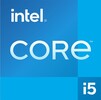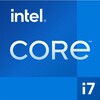Intel Core i5-12400F vs Intel Core i5-12450H vs Intel Core i7-12650H
Intel Core i5-12400F
► remove from comparisonThe Intel Core i5-12400F is a fast six-core processor based on the Alder Lake architecture, which was introduced in January 2022. The processor has a base clock speed of 2.5 GHz and reaches a maximum clock speed of up to 4.4 GHz under load. As with its predecessor, the Intel Core i5-11400F, Alder-Lake also supports hyperthreading, which means that up to 12 threads can be processed simultaneously. The Intel Core i5-12400F is manufactured using the 10 nm process. There are many changes to the new architecture, which is essentially based on a hybrid architecture. However, the Intel Core i5-12400F does not fully benefit from this, as only P-cores are used under the heatspreader. Only with the faster Intel Core i5-12600K can you enjoy the performance of the combination of P and E cores. The Intel Core i5-12400F is a non-K CPU, which in turn means that there is no freely selectable multiplier, which means that the CPU is not suitable for overclocking.
Performance
Compared to the Intel Core i5-11400F , the IPC of the Intel Core i5-12400F has been significantly increased again. The performance difference between the two processors is between 10 and 20 percent in most cases. Due to the good single-thread performance, the Intel Core i5-12400F is definitely a sensible CPU to use as the basis in a gaming PC.
Graphics unit
The processors marked with an "F" in the nomenclature do not offer an integrated graphics unit. All other non-F processors can rely on the Intel Iris Xe.
Power consumption
The TDP is relatively low at 65 watts. This is the PL1 value. For Turbo, the Intel Core i5-12400F with PL2 offers a higher TDP of up to 117 watts. If all restrictions are deactivated in the BIOS, there is no time limit for the PL2 value. With the maximum 117 watts, a large cooling unit is not required.
Intel Core i5-12450H
► remove from comparison
The Intel Core i5-12450H is a high-end mobile CPU for laptops based on the Alder Lake architecture. It was announced in early 2022 and offers 4 of the 6 performance cores (P-cores, Golden Cove architecture) and 4 of the 8 efficient cores (E-cores, Gracemont architecture) leading to 8 cores in total (octa core CPU). The P-cores support Hyper-Threading leading to 12 supported threads when combined with the E-cores. The clock rate ranges from 2 to 4.4 GHz on the performance cluster and 1.5 to 3.3 GHz on the efficient cluster. The performance of the E-cores should be similar to old Skylake cores (compare to the Core i7-6700HQ). All cores can use up to 12 MB L3 cache. Compared to the 12500H, the 12450H offers less E-cores, lower clock rates, a slower iGPU and no vPro support.
Performance
The average 12450H in our extensive database is a bit of a disappointment, its multi-thread benchmark scores only just matching those of the Ryzen 7 5700U and the Core i7-10750H, both fairly old chips as of Q2 2023.
Your mileage may vary depending on how high the CPU power limits are and how competent the cooling solution of your system is.
Features
The integrated memory controller supports various memory types up to DDR5-4800, DDR4-3200, LPDDR5-5200, and LPDDR4x-4267. The Thread Director (in hardware) can support the operating system to decide which thread to use on the performance or efficient cores for the best performance. For AI tasks, the CPU also integrates GNA 3.0 and DL Boost (via AVX2). Quick Sync in version 8 is the same as in the Rocket Lake CPUs and supports MPEG-2, AVC, VC-1 decode, JPEG, VP8 decode, VP9, HEVC, and AV1 decode in hardware. The CPU only supports PCIe 4.0 (x8 for a GPU and two x4 for SSDs).
The integrated graphics adapter is based on the Xe-architecture and offers 48 of the 96 EUs (Execution Units) operating at up to 1.2 GHz.
The CPU is rated at 45 W base power (95 W PL2) but most laptops will use a PL1 of around 60 Watt. The SoC is manufactured in a 10nm process at Intel, which is known as Intel 7.
Intel Core i7-12650H
► remove from comparison
The Intel Core i7-12650H is a high-end mobile CPU for laptops based on the Alder Lake architecture. It was announced in early 2022 and offers 6 performance cores (P-cores, Golden Cove architecture) and 4 of the 8 efficient cores (E-cores, Gracemont architecture). The P-cores support Hyper-Threading leading to 16 supported threads when combined with the E-cores. The clock rate ranges from 2.3 to 4.7 GHz on the performance cluster and 1.7 to 3.5 GHz on the efficient cluster. The performance of the E-cores should be similar to old Skylake cores (compare to the Core i7-6700HQ). All cores can use up to 24 MB L3 cache. Compared to the 12700H, the 12650H offers only 4 instead of 8 E-cores, a slower iGPU and no vPro features (for remote management).
Performance
The average 12650H in our database is in the same league as the Core i9-11950H, Ryzen 5 7640HS, Ryzen 9 5900HS, as far as multi-thread benchmark scores are concerned. This is a very good result, as of early 2023.
Thanks to its decent cooling solution and a long-term CPU power limit of 80 W, the TUF Dash F15 FX517ZR is among the fastest laptops built around the 12650H that we know of. It can be more than 25% faster in CPU-bound workloads than the slowest system featuring the same chip in our database, as of August 2023.
Features
The integrated memory controller supports various memory types up to DDR5-4800, DDR4-3200, LPDDR5-5200, and LPDDR4x-4267. The Thread Director (in hardware) can support the operating system to decide which thread to use on the performance or efficient cores for the best performance. For AI tasks, the CPU also integrates GNA 3.0 and DL Boost (via AVX2). Quick Sync in version 8 is the same as in the Rocket Lake CPUs and supports MPEG-2, AVC, VC-1 decode, JPEG, VP8 decode, VP9, HEVC, and AV1 decode in hardware. The CPU only supports PCIe 4.0 (x8 for a GPU and two x4 for SSDs).
The integrated graphics card is based on the Xe-architecture and offers 64 of the 96 EUs (Execution Units) operating at up to 1.4 GHz.
Power consumption
This Core i7 has a "minimum assured" power consumption of 35 W, with 45 W being its Base power consumption. The processor's maximum Intel-recommended Turbo power consumption sits at 115 W. It would take at least two fans to cool such a beast.
Last but not the least, Intel Core i7-12650H is built with Intel's fourth-generation 10 nm process marketed as Intel 7 for OK, as of early 2023, energy efficiency.
| Model | Intel Core i5-12400F | Intel Core i5-12450H | Intel Core i7-12650H | ||||||||||||||||||||||||||||||||||||||||||||||||||||||||
| Codename | Alder Lake-S | Alder Lake-H | Alder Lake-H | ||||||||||||||||||||||||||||||||||||||||||||||||||||||||
| Series | Alder Lake-S | Intel Alder Lake-P | Intel Alder Lake-P | ||||||||||||||||||||||||||||||||||||||||||||||||||||||||
| Clock | 2500 - 4400 MHz | 1500 - 4400 MHz | 1700 - 4700 MHz | ||||||||||||||||||||||||||||||||||||||||||||||||||||||||
| L1 Cache | 480 KB | 704 KB | 864 KB | ||||||||||||||||||||||||||||||||||||||||||||||||||||||||
| L2 Cache | 7.5 MB | 8 MB | 9.5 MB | ||||||||||||||||||||||||||||||||||||||||||||||||||||||||
| L3 Cache | 17.9 MB | 12 MB | 24 MB | ||||||||||||||||||||||||||||||||||||||||||||||||||||||||
| Cores / Threads | 6 / 12 | 8 / 12 | 10 / 16 | ||||||||||||||||||||||||||||||||||||||||||||||||||||||||
| TDP | 65 Watt | 45 Watt | 45 Watt | ||||||||||||||||||||||||||||||||||||||||||||||||||||||||
| Technology | 10 nm | 10 nm | 10 nm | ||||||||||||||||||||||||||||||||||||||||||||||||||||||||
| Die Size | 163 mm2 | ||||||||||||||||||||||||||||||||||||||||||||||||||||||||||
| max. Temp. | 100 °C | 100 °C | 100 °C | ||||||||||||||||||||||||||||||||||||||||||||||||||||||||
| Socket | 1700 | BGA1744 | BGA1744 | ||||||||||||||||||||||||||||||||||||||||||||||||||||||||
| Features | TVB, HyperThreading, AVX, AVX2, FMA3, Quick Sync, Virtualization | DDR4-3200/LPDDR4x-4266/DDR5-4800/LPDDR5-5200 RAM, PCIe 4, Thr. Director, DL Boost, GNA, MMX, SSE, SSE2, SSE3, SSSE3, SSE4.1, SSE4.2, AVX, AVX2, BMI2, ABM, FMA, ADX, VMX, SMX, SMEP, SMAP, EIST, TM1, TM2, HT, Turbo, SST, AES-NI, RDRAND, RDSEED, SHA | DDR4-3200/LPDDR4x-4266/DDR5-4800/LPDDR5-5200 RAM, PCIe 4, Thr. Dir., DL Boost, GNA, MMX, SSE, SSE2, SSE3, SSSE3, SSE4.1, SSE4.2, AVX, AVX2, BMI2, ABM, FMA, ADX, SMEP, SMAP, EIST, TM1, TM2, HT, Turbo, SST, AES-NI, RDRAND, RDSEED, SHA | ||||||||||||||||||||||||||||||||||||||||||||||||||||||||
| Architecture | x86 | x86 | x86 | ||||||||||||||||||||||||||||||||||||||||||||||||||||||||
| $180 U.S. | |||||||||||||||||||||||||||||||||||||||||||||||||||||||||||
| Announced | |||||||||||||||||||||||||||||||||||||||||||||||||||||||||||
| Manufacturer | www.intel.de | ark.intel.com | ark.intel.com | ||||||||||||||||||||||||||||||||||||||||||||||||||||||||
| Series: Alder Lake-P Alder Lake-H |
|
| |||||||||||||||||||||||||||||||||||||||||||||||||||||||||
| iGPU | Intel UHD Graphics Xe G4 48EUs ( - 1200 MHz) | Intel UHD Graphics 64EUs (Alder Lake 12th Gen) ( - 1400 MHz) |
Benchmarks
Average Benchmarks Intel Core i5-12400F → 100% n=47
Average Benchmarks Intel Core i5-12450H → 86% n=47
Average Benchmarks Intel Core i7-12650H → 97% n=47
* Smaller numbers mean a higher performance
1 This benchmark is not used for the average calculation













